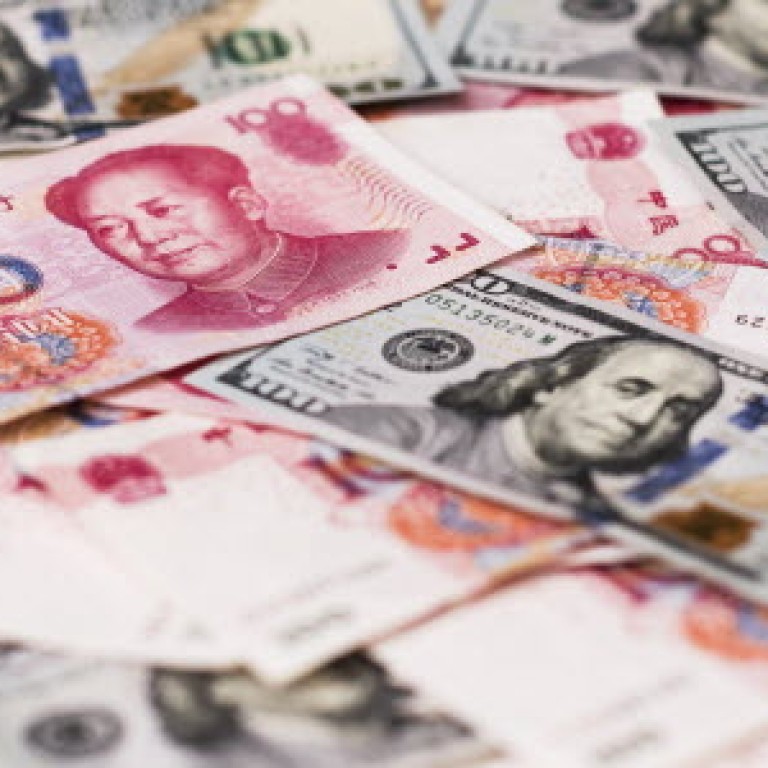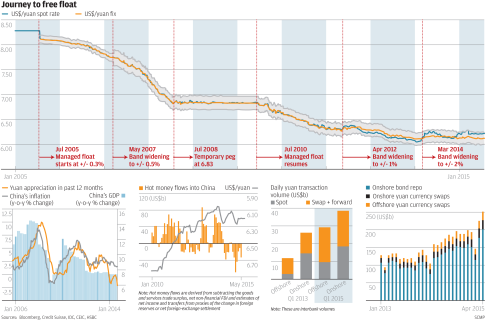
More currency reform expected from Beijing, 10 years after yuan peg removed
Bankers and traders expect Beijing will carry out more currency reforms to boost the international status of the yuan and further liberalise capital controls, 10 years after its landmark move to break the mainland currency’s peg to the US dollar.
“After 10 years of ‘managed float’ for the onshore yuan, the journey to free float has only just begun,” Credit Suisse senior currency strategist Heng Koon-how said.
On July 21, 2005, the People’s Bank of China freed the yuan from its 8.28 peg to the US dollar and allowed the currency to appreciate by 2.1 per cent.
The daily fixing should cease tracking the USD, be more transparent, market-determined, and less influenced by the People’s Bank of China
The removal of the peg did not see the yuan become a free float currency, instead entering into what Heng describes as a ‘managed float’ against the US dollar. The People’s Bank of China announces a mid-price for the yuan at 9.15am each trading day, with traders able to trade up or down in a set band. The range was originally set at 0.3 per cent either side of the mid-price, before being widened to 0.5 per cent in May 2007, 1 per cent in April 2012 and 2 per cent in March last year.
In the past 10 years the yuan has appreciated 25 per cent from 8.28 to 6.20 to the US dollar, a level Heng said it was likely to maintain in the near term.
“The International Monetary Fund (IMF) has now finally suggested that the onshore yuan may be near its neutral valuation,” he said. “However, the US Treasury continues to reiterate its long running view that the onshore yuan needs to appreciate further.”

“The near term focus of the People’s Bank of China is to encourage the IMF to add the yuan into its Special Drawing Rights (SDR) basket this October,” Heng said. “But that is by no means the end game. Over the long run, it is clear that for the yuan to mature into a global reserve currency of true weight that can rival the US dollar and euro, the Chinese authorities need to take a leap of faith and allow the yuan to trade freely with no pre-determined daily trading band and China’s capital account needs to be opened up fully for free, two-way investment capital flow.”
Paul Mackel, head of global emerging markets foreign exchange research at HSBC, also expects Beijing to introduce more currency reforms.
“There could be important changes to the onshore USD-CNY trading band via the reference rate, and/or the width of the band,” Mackel said in a research report. “The daily fixing should cease tracking the USD, be more transparent, market-determined, and less influenced by the People’s Bank of China. Such reforms will take time.”
Mackel said he believed Beijing would first widen the trading band to allow more room for the spot exchange rate to move. Then he expected Beijing might allow the onshore yuan USD/CNY to eventually converge with the offshore yuan USD/CNH into a single floating exchange rate as cross-border capital flow channels were widened and the offshore market deepened.
“The offshore USD-CNH exchange rate is not bound by the trading band and is already very much market-determined,” he said. “We have recently observed that it occasionally leads developments in the onshore exchange rate.
“The steps taken towards full convertibility will also have played a vital role in reforms of China’s domestic economy and financial system. We believe the inclusion in the IMF’s Special Drawing Rights (SDR) basket will be inevitable, meaning the yuan will have gone from a hard peg behind tight capital controls only a decade ago to being an anchor of global trade, investment and finance.”

